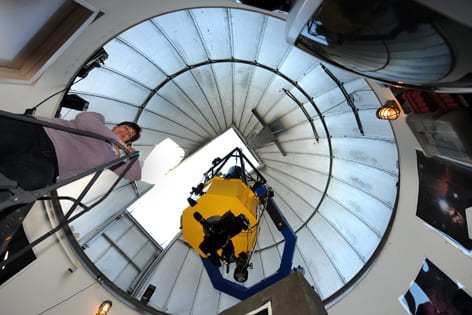Venus, Saturn through a telescope
Have you ever seen Venus or Saturn through a telescope? How about the Orion Nebula or star clusters? Come view these celestial bodies and more during UCI Observatory Visitor Night from 7-9 p.m. Saturday, Feb. 21.

Have you ever seen Venus or Saturn through a telescope? How about the Orion Nebula or star clusters? Come view these celestial bodies and more during UC Irvine Observatory Visitor Night from 7-9 p.m. Saturday, Feb. 21.
Visitor night gives the public a chance to stargaze through powerful telescopes while learning about space, astronomy and all that twinkles in the evening sky.
James Bullock, head of UCI’s Center for Cosmology, will lecture at 7:15 p.m. and 8:15 p.m. at the observatory on the origin and nature of the universe and on dark matter, the mysterious substance that makes up five-sixths of all matter.
Visitors are advised to dress warmly and bring flashlights. Amateur astronomers are encouraged to bring their own telescopes to share.
The event is free, and reservations are not required. Parking is $7 in the ICS/Engineering Parking Structure at the corner of East Peltason and Anteater drives. Shuttle buses will take visitors every 10 to 15 minutes from the parking area to the gravel road leading to the observatory near the intersection of Gabrielino Drive and California Avenue.
Tammy Smecker-Hane, observatory director, discusses Visitor Night, the observatory and her interest in astronomy:
Q: What is the history of visitor night?
A: Visitor nights began in October 1999 when Astronomy Club at UCI undergraduates suggested the idea to me. Visitor nights became more frequent in 2003 when I received funding from the UCI FOCUS Program that received a National Science Foundation grant dedicated to science outreach and teacher education. I developed a staff of student volunteers who serve as Visitor Night hosts, give observatory tours and bring telescopes, lectures and hands-on activities to K-12 students in local schools through our Astronomy Outreach Program.
Q: What happens during a typical visitor night?
A: Visitor nights have been a great success, with attendance of 500 to 1,000 people on clear nights. But even on cloudy nights, we still get about 150 people. Visitors are treated to a 30-minute presentation on a topic involving planets, stars, galaxies or cosmology, with a lively question-and-answer period at the end. We set up six to 10 telescopes ranging in size from 8 inches to 24 inches in diameter so people can see planets, stars, star clusters and nebulae with their own eyes. We also hand out free night sky maps so people can locate their favorite constellations and identify planets and star clusters visible at that particular time of year.
Q: What do you like about visitor nights?
A: My students and I get a big kick out of seeing how interested people are in astronomy. Visitors’ many questions range from the practical – “Is that bright orange dot a planet or star?” – to the abstract, such as “How did the universe begin?” It’s fun to answer their questions, though sometimes we have to admit we don’t know for sure because astronomers still are working to figure it out.
Q: How is the observatory used, other than on visitor night?
A: The introductory astronomy series taught by the Department of Physics & Astronomy uses the observatory. Undergraduate physics majors can conduct experiments with the telescopes. The Astronomy Club at UCI meets at the observatory every two weeks to explore the night sky. Talented high school students in the COSMOS program use the observatory during the summer. In advanced classes, students make more detailed observations using an imaging camera or spectrograph. The camera takes digital images of objects at specific wavelengths, which lets us derive the location, luminosity and temperature of an object. For example, students in Physics 139 image Jupiter and four of its moons. By mapping the orbital motion of the moons over time, they derive the mass of Jupiter.
Q: What interests you about astronomy and the observatory?
A: I like astronomy because, at its essence, it is about making observations of the universe and comparing them with theories based on our knowledge of basic physics. We try to understand some very intriguing questions: Are there planets other than Earth that could support life? How old are stars and galaxies? Why is the universe expanding at an ever-increasing rate? Astrophysics is a fairly young science. Some questions we have solved, but oftentimes when you solve one, it spawns a whole other set of questions. There is a lot of work to be done in astrophysics, and newer, larger telescopes and better instrumentation are giving us the ability to tackle these new questions.